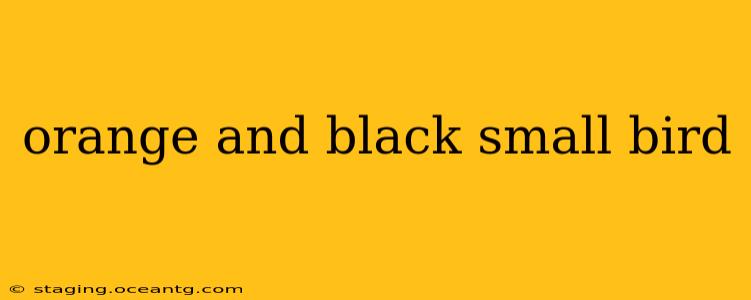Spotting a small bird with vibrant orange and black plumage can be quite exciting! Many species boast this striking color combination, making identification a fun challenge. This guide will help you narrow down the possibilities, exploring various species and their distinguishing features. We'll cover habitats, behaviors, and other key characteristics to assist in your birdwatching endeavors.
What are some common orange and black small birds?
This depends heavily on your geographic location. The same orange and black bird in North America could be entirely different from one seen in South America or Europe. However, some commonly sighted species known for their orange and black markings include:
- American Goldfinch (Spinus tristis): This tiny bird is a classic example, exhibiting bright yellow (which can appear orange in certain lights) and black plumage. Males are particularly striking during breeding season. They are found throughout North America.
- Baltimore Oriole (Icterus galbula): Slightly larger than a Goldfinch, the male Baltimore Oriole boasts a rich, deep orange body with black wings and tail. They are common in eastern North America.
- Blackburnian Warbler (Setophaga fusca): These warblers are known for their vibrant orange throat patches contrasting beautifully with their black and white markings. They are found across parts of North America.
- Orange-crowned Warbler (Leiothlypis celata): While less intensely orange than some other species, this warbler has a subtle orange crown that is often visible, along with olive-green and black markings. Their range is vast, including much of North America and into Central America.
- Various Tanagers: Several tanager species in Central and South America showcase orange and black plumage. Specific identification would require more details regarding the location and specific markings.
What size bird are we talking about?
Knowing the approximate size of the bird is crucial. Is it smaller than a sparrow, similar in size, or larger? A rough estimate (e.g., "about the size of my thumb," "slightly smaller than a robin") can be very helpful in narrowing down the possibilities.
Where did you see this orange and black bird?
The bird's geographic location is paramount for accurate identification. Are you in a forest, a meadow, a suburban area, near water? The bird's habitat provides valuable clues about its identity. Providing specific location details (city, state, country) can greatly enhance the identification process.
What time of year did you see it?
Migration patterns influence the presence of certain birds in specific regions. Knowing the time of year helps determine if the bird is a resident species or a seasonal visitor.
What other identifying features did you notice?
Beyond the orange and black coloration, any additional details are invaluable. Consider the following:
- Shape and size of the beak: Is it long and slender, short and stout, or something in between?
- Length and shape of the tail: Is the tail long and pointed, short and rounded, or forked?
- Behavior: What was the bird doing? Was it foraging on the ground, flitting among branches, or singing a particular song?
- Specific shades of orange and black: Was the orange more of a fiery red-orange or a paler, yellowish-orange? Was the black a deep, glossy black or more of a dull, sooty black?
By carefully considering these details, you'll significantly increase your chances of correctly identifying the small orange and black bird you've encountered. Remember to utilize online bird identification resources with detailed images and range maps for further assistance. Happy birding!
